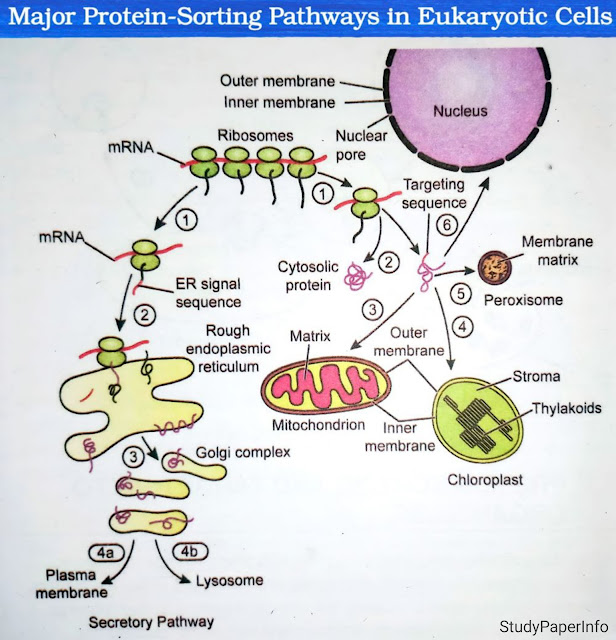Explain with the help of schematic diagram, protein-sorting pathways in eukaryotic cells
Protein sorting in eukaryotic cells is the highly regulated process through which newly synthesized proteins are directed to their correct destinations within or outside the cell. It is crucial for maintaining cellular structure, function and homeostasis. This process ensures that enzymes, structural proteins and signaling molecules reach their functional compartments such as the nucleus, mitochondria, endoplasmic reticulum (ER), lysosomes, plasma membrane, or extracellular space. The sorting mechanism relies on signal sequences in the proteins, cellular recognition systems and various sorting pathways. These pathways are crucial for maintaining cellular compartmentalization and function.
There are two major types of protein-sorting pathways in eukaryotic cells:
- Co-translational targeting to the endoplasmic reticulum (ER)
- Post-translational targeting to other organelles like the nucleus, mitochondria and peroxisomes.
1. Co-translational Sorting Pathway (ER-Dependent Pathway)
In this pathway, proteins that need to be sent outside the cell (secreted), or sent to the plasma membrane, or sent to lysosomes, are made on ribosomes that are attached to the rough endoplasmic reticulum (ER). These proteins contain an N-terminal signal peptide that is recognized by the Signal Recognition Particle (SRP). The SRP binds the ribosome and halts translation temporarily. This complex docks onto the SRP receptor on the ER membrane. The ribosome then binds to a translocon (protein channel) in the ER membrane and translation resumes, threading the growing polypeptide into the ER lumen. After entering the ER, the protein may undergo folding, glycosylation and quality control. Correctly folded proteins are packaged into vesicles and sent to the Golgi apparatus, where they are further modified and sorted into transport vesicles bound for the plasma membrane, lysosomes, or secretion outside the cell.
2. Post-translational Sorting Pathway (ER-Independent Pathway)
Proteins destined for organelles like mitochondria, chloroplasts (in plant cells), peroxisomes and the nucleus are synthesized fully in the cytosol and then sorted after translation. These proteins contain specific targeting sequences that are recognized by receptor proteins associated with the respective organelle. Based on their final destination, different targeting mechanisms are used to ensure proper delivery.
- Mitochondrial and Chloroplast Proteins: Mitochondrial and chloroplast proteins are recognized by receptors located on the surface of these organelles. With the help of chaperone proteins, these polypeptides are kept in an unfolded state and then translocated across the organelle membranes through specialized protein complexes known as translocases. Once inside, the proteins refold into their functional structures and may undergo additional processing if required.
- Nuclear Proteins: Nuclear proteins carry specific signals called nuclear localization signals (NLS). These are identified by transport proteins known as importins, which guide the proteins through the nuclear pore complexes. This movement is energy-dependent and allows proteins to enter the nucleus while maintaining proper regulation.
- Peroxisomal Proteins: In the case of peroxisomal proteins, they contain peroxisomal targeting signals (PTS), which ensure their delivery to the peroxisome. Unlike mitochondrial or chloroplast proteins, these are typically imported in their folded state through specialized translocation channels present on the peroxisomal membrane.




Comments
Post a Comment